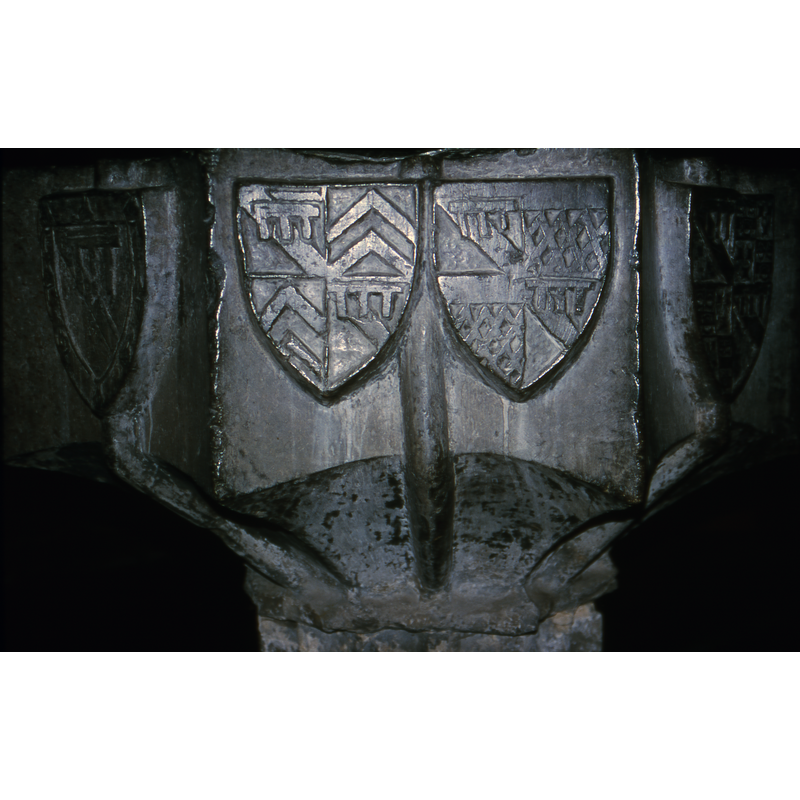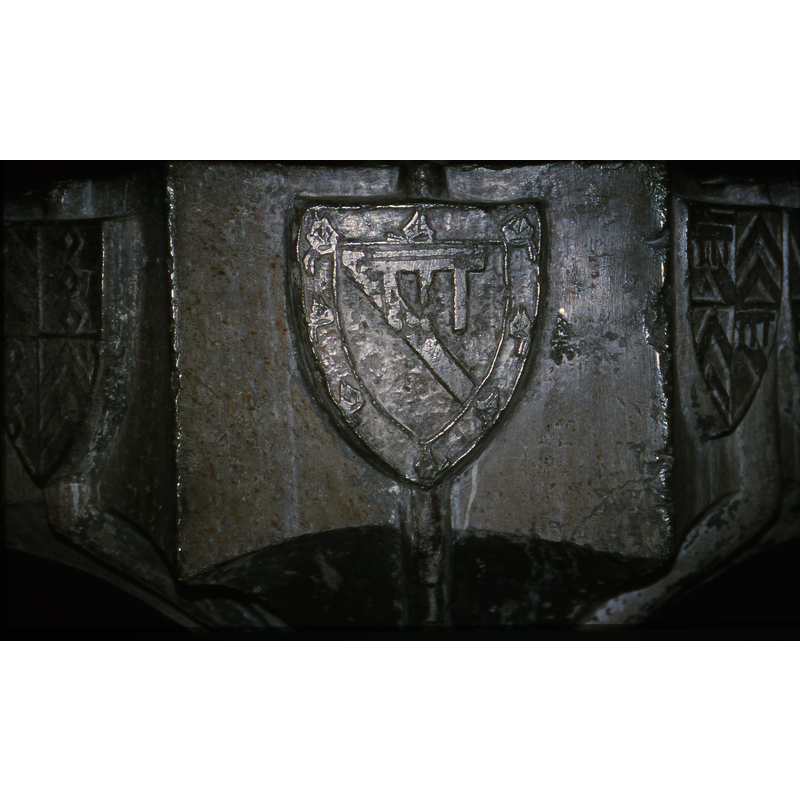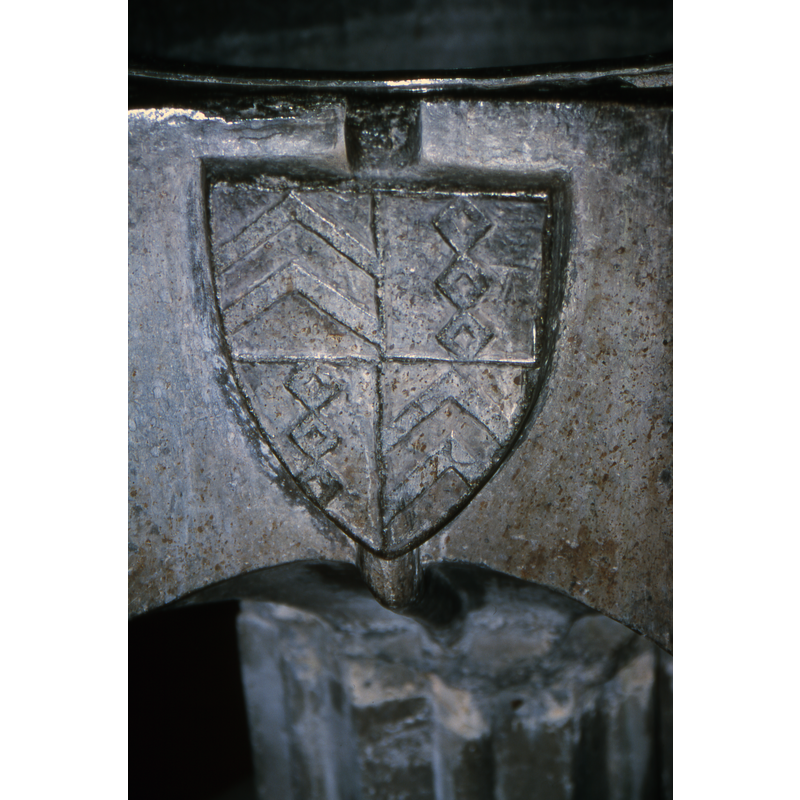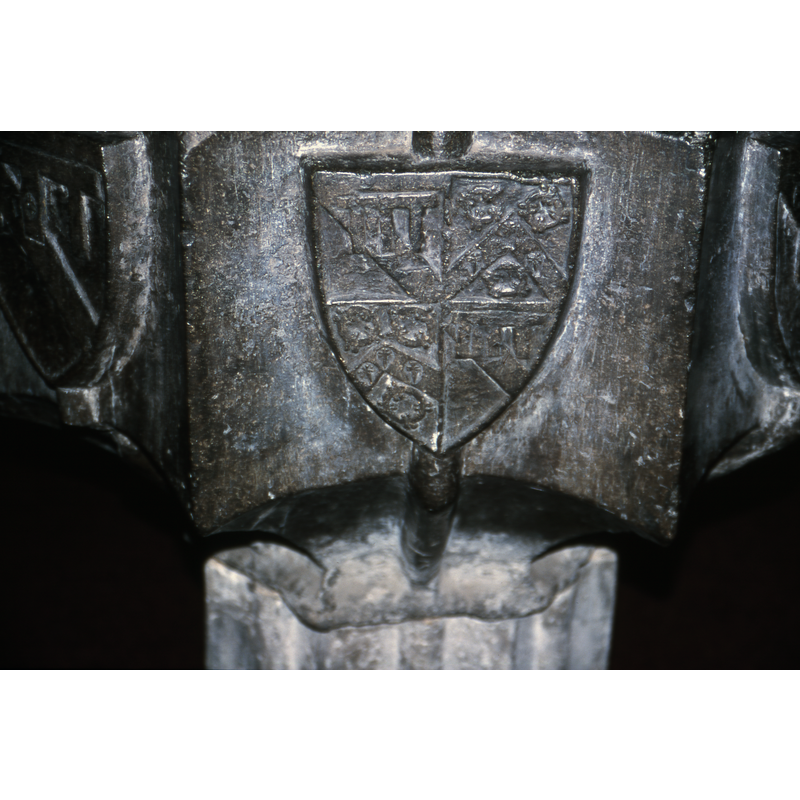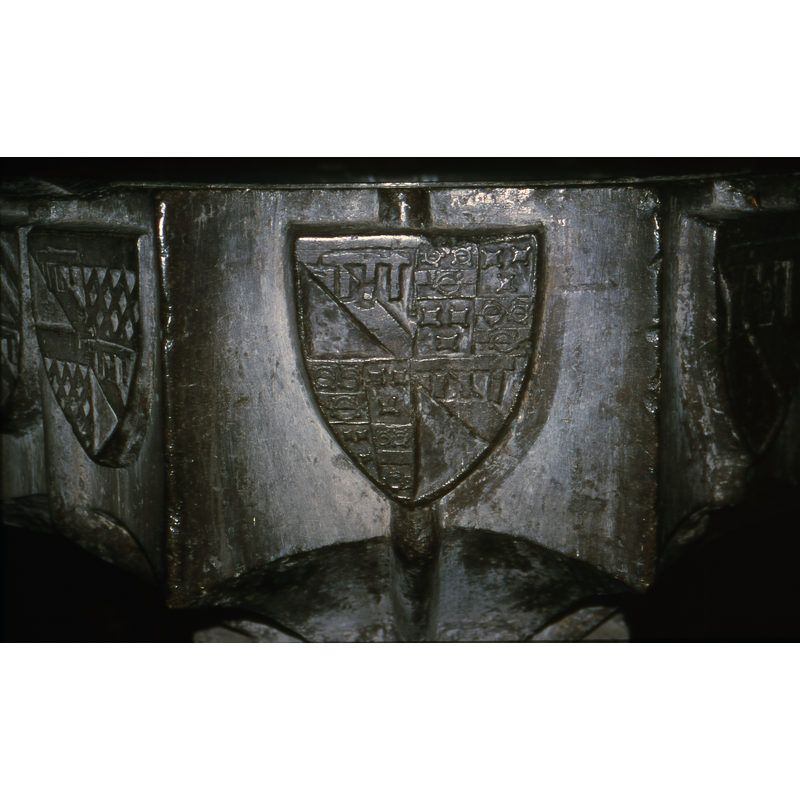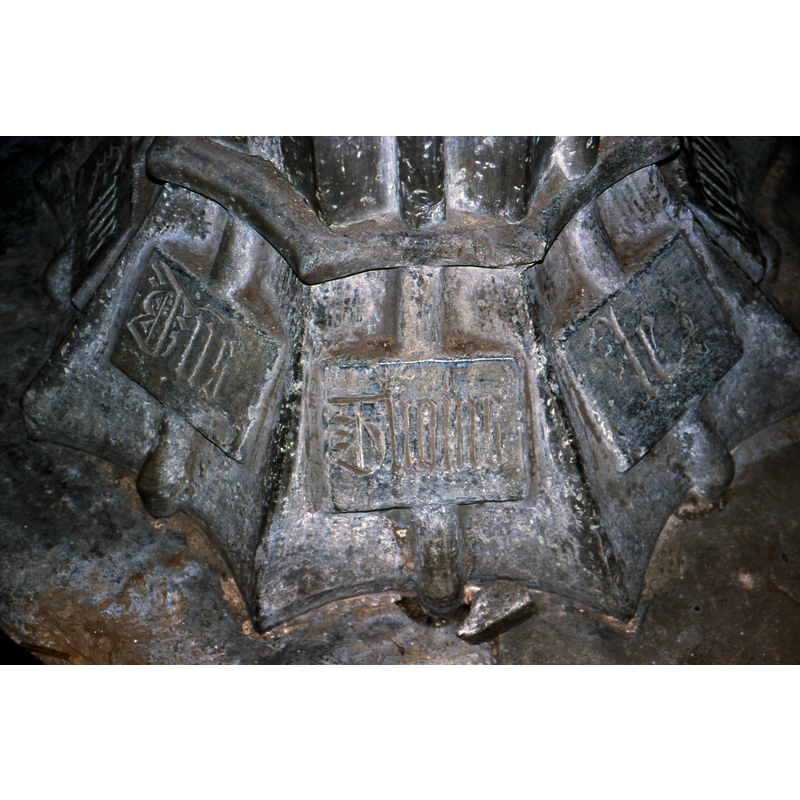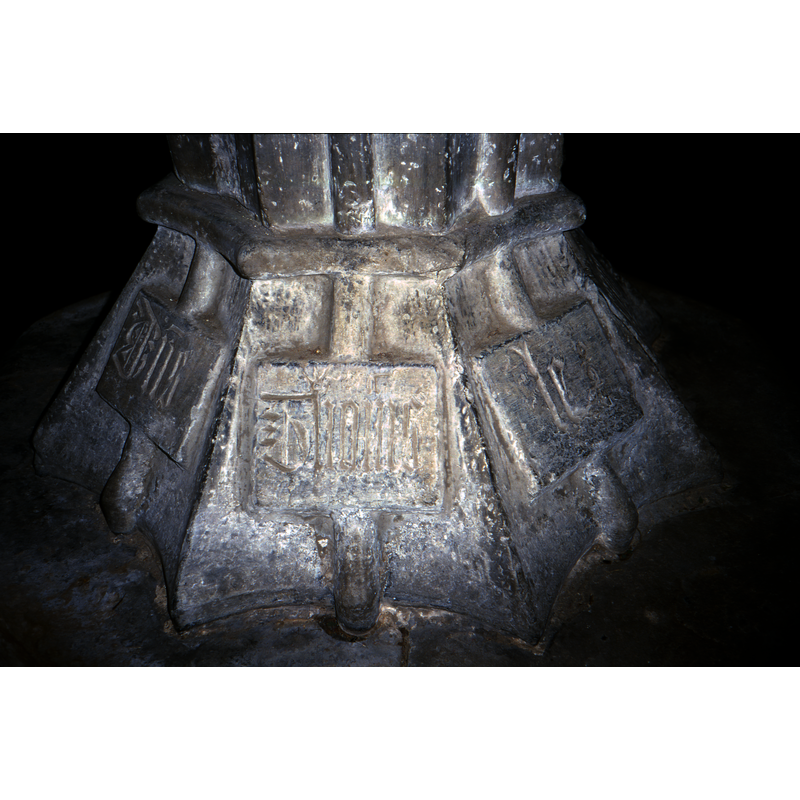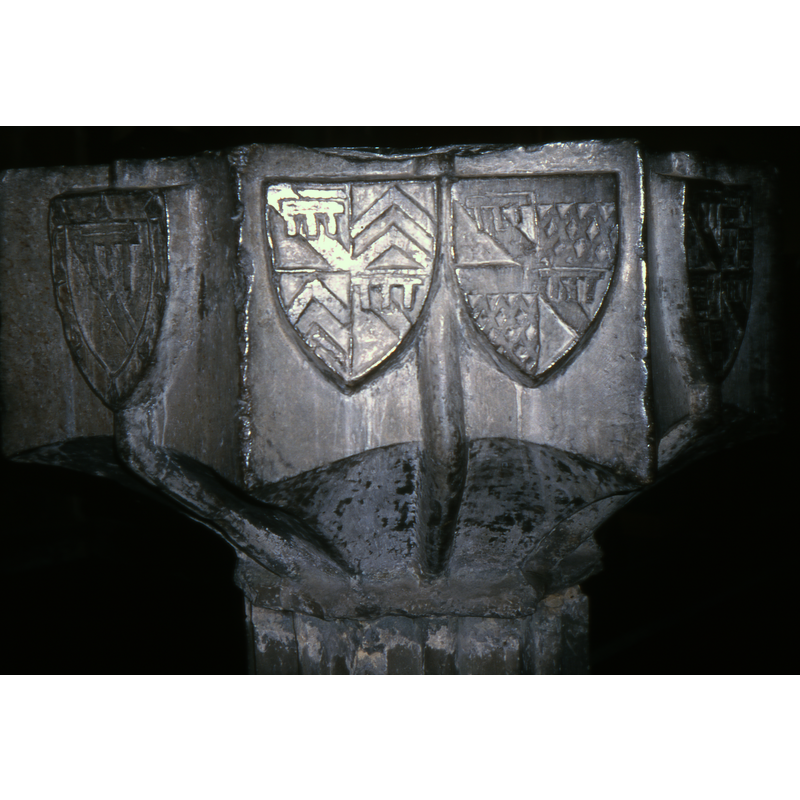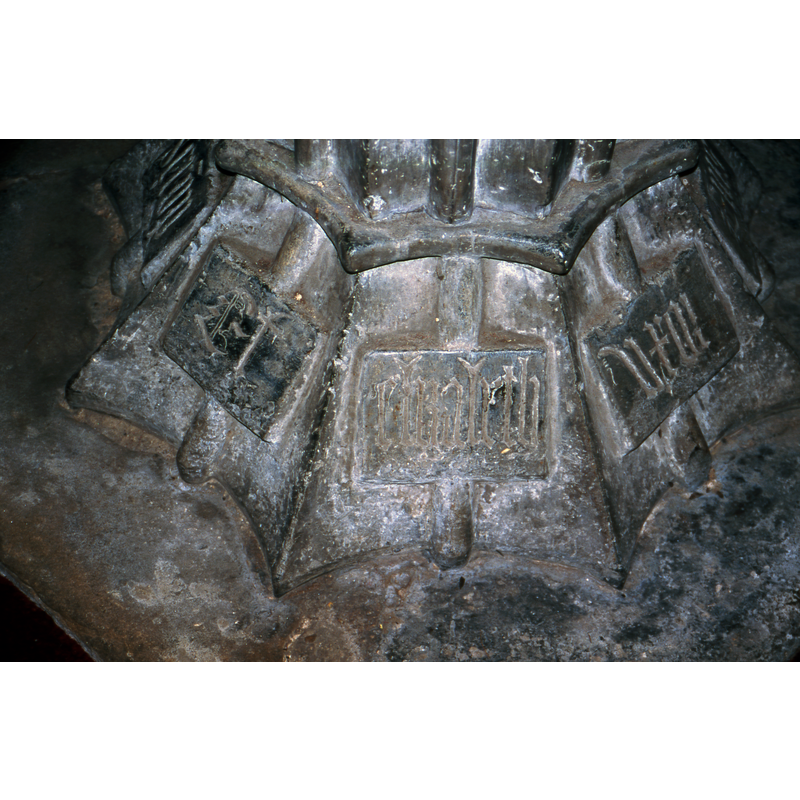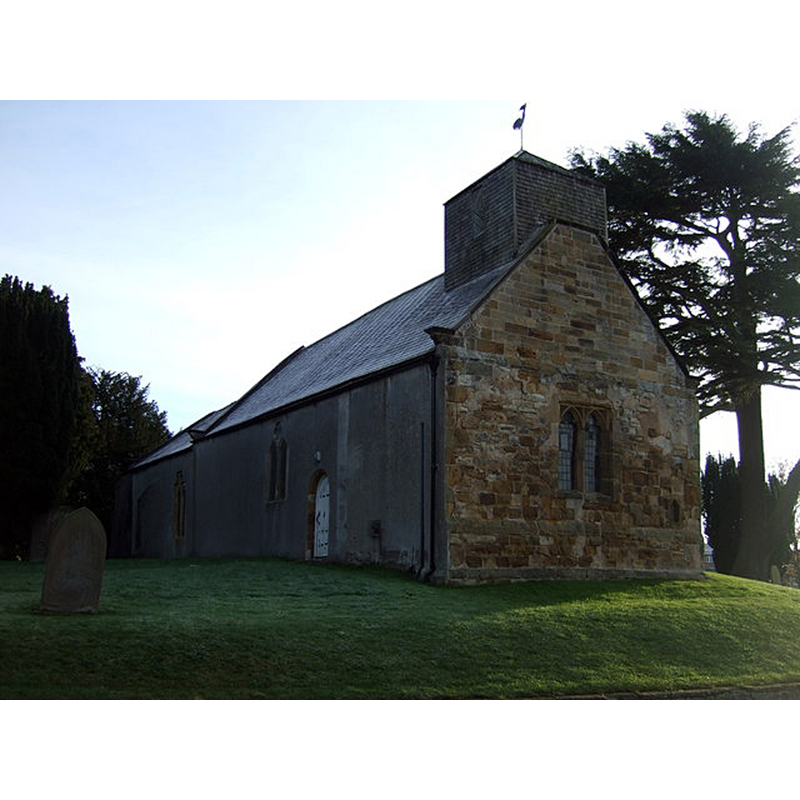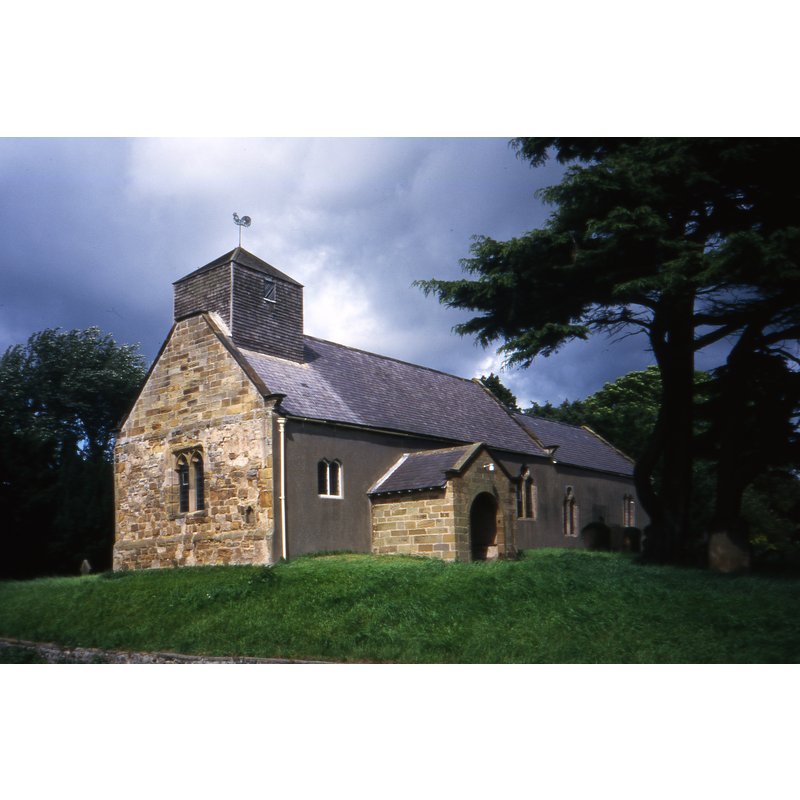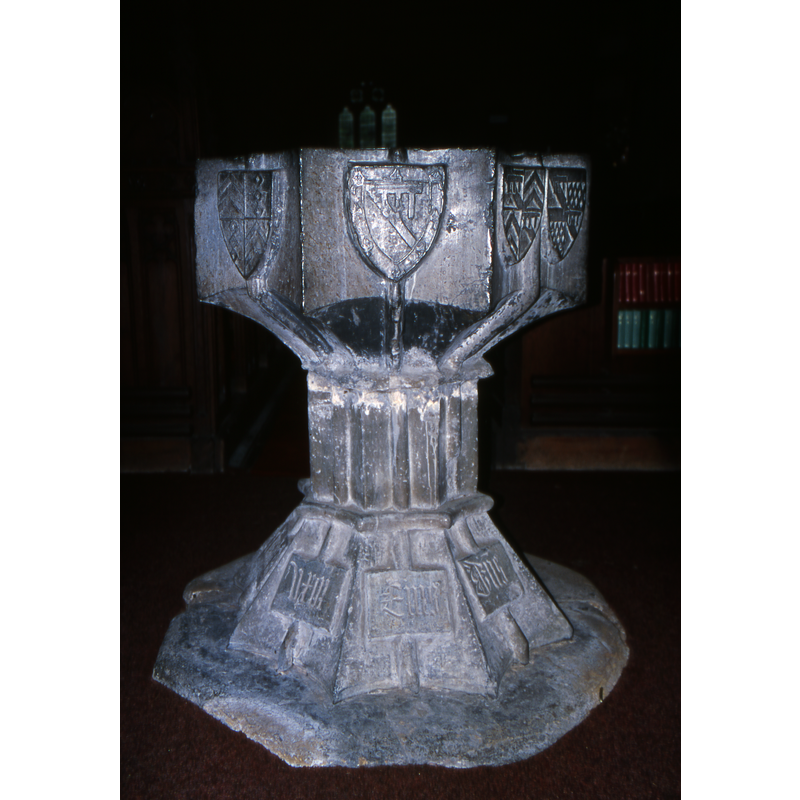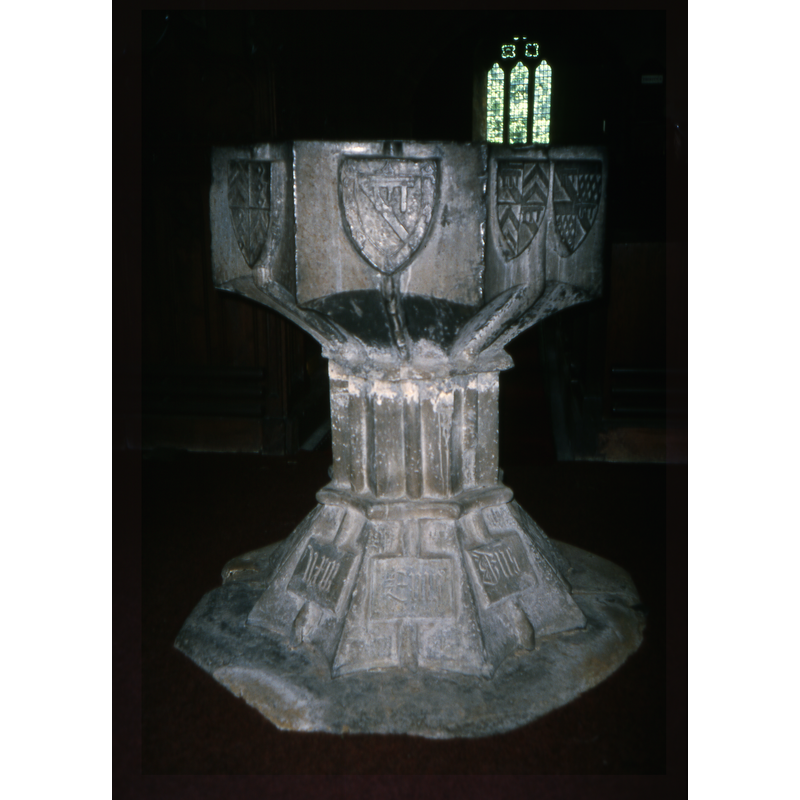South Kilvington No. 1
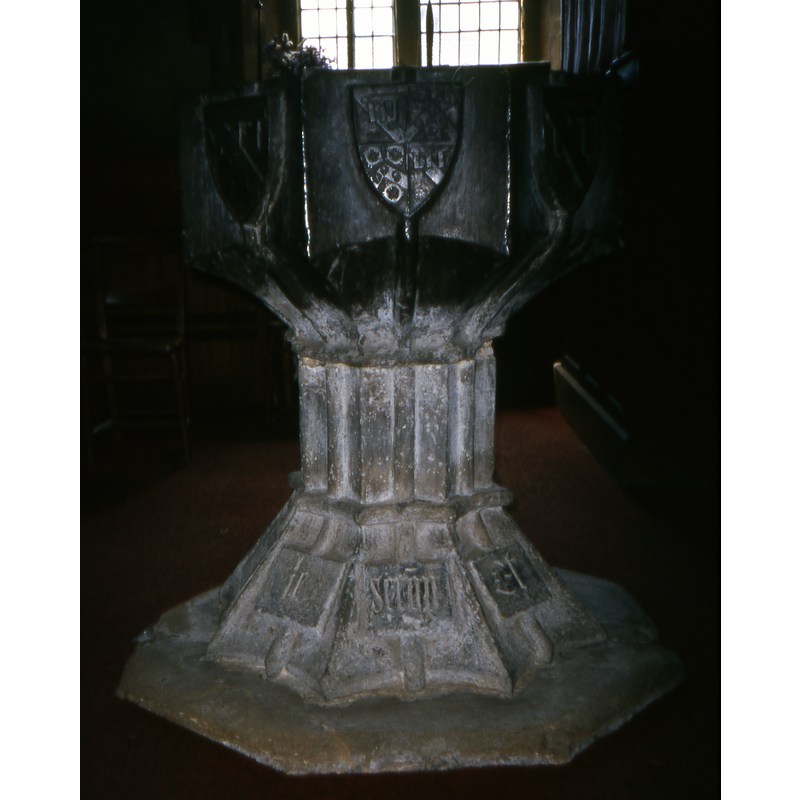
Image copyright © Baptisteria Sacra Index, 2023
Results: 21 records
B01: coat of arms - Scrope family
B02: coat of arms - Scrope family
B03: coat of arms - Scrope family
B04: coat of arms - Scrope family
B05: coat of arms - Scrope family
B06: coat of arms - Scrope family
B07: coat of arms - Scrope family
B08: coat of arms - Scrope family
LB03: inscription
design element - motifs - moulding and piping
Scene Description: the roll moulding at the upper neck of the stem of the base is much damaged but still discernible -- a vertical pipe that originates on each basin side and runs down the underbowl chamfer, also continues 'behind' the centre ring and down each side of the octagonal stem of the base; it proceeds farther down the lower base as well
Copyright Statement: Image copyright © Baptisteria Sacra Index, 2023
Image Source: digital image of a photograph taken 13 July 1998 by BSI
design element - motifs - moulding and piping
Scene Description: as is the case on the basin sides, a vertical pipe runs from the stem of the base, behind the horizontal moulding at the neck of the lower base, and down the lower base behind the rectangular plaques that bear the inscription
Copyright Statement: Image copyright © Baptisteria Sacra Index, 2023
Image Source: digital image of a photograph taken 13 July 1998 by BSI
design element - motifs - piping
Scene Description: a single verttical pipe runs from the upper rim down the side of the basin to the bottom of the underbowl; it runs either between two shields, as in the case here, in the centre panel, or behind the shield, as is the case here in the left and right panels
Copyright Statement: Image copyright © Baptisteria Sacra Index, 2023
Image Source: digital image of a photograph taken 13 July 1998 by BSI
information
inscription
inscription
view of church exterior - northwest view
view of church exterior - southwest view
view of font
view of font
view of font
INFORMATION
FontID: 01191KIL
Object Type: Baptismal Font1
Church/Chapel: Parish Church of St. Wilfrid
Church Patron Saints: St. Wilfrid [aka Wilfred, Wilfrith]
Church Location: Stockton Rd, South Kilvington, Thirsk YO7 2NN, UK
Country Name: England
Location: North Yorkshire, Yorkshire and the Humber
Directions to Site: Located off the A61, W of the A19, 2 km N of Thirsk town centre
Ecclesiastic Region: Diocese of York
Historical Region: Wapentake of Birdforth
Font Location in Church: Inside the church, at the W end in centre of nave, just inside S doorway
Date: ca. 1415?
Century and Period: 15th century (late), Perpendicular
Workshop/Group/Artisan: heraldic font
Cognate Fonts: Catterick, South Cowton, Ripon Minster and Richmond (N. Yorks.). Also the font at Bolton by Bowland
Font Notes:
Click to view
No individual entry found for South Kilvington in the Domesday survey. The font here is described with full details of its armorial devices by Waddilove in 1808 [cf. infra]. In Moule (1837). Poole (1842) and Pugin (1843) refer to this font as "decidedly inelegant". Listed in Paley (1844) as a hexagonal baptismal font decorated with heraldic devices. Sheahan & Whellan (1857), who make references to Dr. Wadilove's 1808 description and the illustration in vol. xvi of Archaeologia, write: ''Here is a curious and interesting font, though it has no claim to high antiquity. It is octangular in shape, and on the eight sides are shields bearing the arms of the noble house of Scrope. The constant tradition of the neighbourhood is, that this font was removed to its present situation from the chapel of Upsal Castle, formerly the seat ofd the Lords Scrope of Masham, Upsal and Flaxtead. The arms of the distinguished family of Scrope (azure, a bend, or), with which it is ornamented, furnish abundant proof that it was the property of, or a gift to the Church from, one of that lineage. The font appears to have been made about the time of Edward IV [1461-1483], and probably by Thomas, the son of Lord John Scrope, Treasurer of England, for the arms of Chaworth, his mother, are engraven on it. In vol. xvi, of the Archaeologia, is a drawing or plate, as well as a description of this font, communicated by Dr. Waddilove, Dean of Ripon, in 1808. That description tells us that 'the first shield is Scrope with a label of three, as younger son of the house of Bolton: the second and third are Scrope also; the second quartering Wanton; the fourth is Scrope impaling a lion rampant with two tails, which may be Cressy, Sutton of Warsop, or Lord Wells's: the fifth is Chaworth quartering Stratham: the sixth is Scrope in a border, which appears to be composed of the bearing of Wanton. The seventh is Scrope quartering Chaworth, and Scrope quartering Fitzwilliam. The eighth is Scrope quartering Wanton, with another coat of arms probably that of Redman.' On the sides of the foot of the font are sculptured armorial bearings now illegible, which have not been constructed by a herald. It may be added that this font much resembles in shape and sculpture, yet of a better design, the font at Bolton of which a is at 106 of Whitaker's History of Craven.'' Noted in Glynne's 18 August 1868 visit to this church (in Butler, 2007), who also mentions "an octagonal stoup near the south door", of which he gives no date. Described in Bulmer's History, Topography, and Directory of North Yorkshire [...] (1890) where a reference is made to Waddilove's description, illustration and identification of the coats-of-armor on this font [cf. Archaeologia, vol. 16]. Bulmer's (ibid.) mentins that this font resembles the one at Bolton [unknown which Bolton it refers to], but it is "yet of better design". Described in Cox & Harvey (1907) as one of three similar black marble fonts, all heraldic, in this county [the other two are Cattarick and Richmond]. The entry for this parish in the Victoria County History (York North Riding, vol. 2, 1923) notes: "A small round-headed window in the south wall points to the 12thcentury origin of the fabric, but this window is the only detail remaining of the date [...] The font dates from the latter part of the 15th century; it is of grey marble and is octagonal in plan with concave sides. On the base are squares inscribed 'Dñs Thom[a]s le Scrōp et Elizabeth uxor ejus,' referring to Thomas Lord Scrope, who married Elizabeth Nevill and died in 1494. On the sides of the bowl are shields with Scrope heraldry." Described in Tyrrell-Green (1928) as a "handsome and elaborately adorned font with very marked concave sides"; T-G (ibid.) identifies "the arms of Lord Scrope, Treasurer of England in the reign of Edward IV, with his maternal arms of Chaworth". According to information available at St Wilfrid's, the font is originally from Upsal Castle and bears the arms of the Scropes. Morris (1931) has this "handsome font of dark marble" as one of several of the Perpendcular period [the group includes Catterick, Cowton, Richmond and South Kilvington] "that have probably been produced at the same workshop." Noted in Pevsner (1985). The entry for this church in Historic England [Listing NGR: SE4258884006] notes; "Church. C12 origins with C13 and C14 windows. Heavily restored C19. [...] Font: black marble
hexagonal bowl with concave sides ornamented with shields. Stone base with donor inscription of Thomas le Scrope (d.14949) and Elizabeth, his wife." On-site notes: the bowl has a shield with a coat of arms in each of the seven sides, the eighth has two shields with coats of arms, those of Thomas Scrope and his wife Elizabeth Neville; all other shields belong to the Scrope family, some quartered with those of relatives by marriage. The font was probably donated to the church by the family in celebration of the wedding. Henry, another Lord of Scrope, was beheaded for high treason in South Hampton in 1415. His brother's son, Thomas, is the one named on the font with his wife Elizabeth. As mentioned above, another source claims that the font was moved to the present location from a chapel in Upsal Castle, a ruin near by. The basin well has a lead lining. Inscription on the base [cf. "inscription area" for text]. That description tells us that 'the first shield is Scrope with a label of three, as younger son of the house of Bolton: the second and third are Scrope also; the second quartering Wanton; the fourth is Scrope impaling a lion rampant with two tails, which may be Cressy, Sutton of Warsop, or Lord Wells's: the fifth is Chaworth quartering Stratham: the sixth is Scrope in a border, which appears to be composed of the bearing of Wanton. The seventh is Scrope quartering Chaworth, and Scrope quartering Fitzwilliam. The eighth is Scrope quartering Wanton, with another coat of arms probably that of Redman.' On the sides of the foot of the font are sculptured armorial bearings now illegible, which have not been constructed by a herald. It may be added that this font much resembles in shape and sculpture, yet of a better design, the font at Bolton of which a is at 106 of Whitaker's History of Craven.''
COORDINATES
Church Latitude & Longitude Decimal: 54.24996, -1.3479
Church Latitude & Longitude DMS: 54° 14′ 59.86″ N, 1° 20′ 52.44″ W
UTM: 30U 607640 6012593
MEDIUM AND MEASUREMENTS
Material: stone, marble (black)
Number of Pieces: two?
Font Shape: octagonal (mounted)
Basin Interior Shape: round
Basin Exterior Shape: octagonal
Drainage Notes: lead-lined well
Rim Thickness: 6 cm (13 cm at corners)
Diameter (inside rim): 62 cm
Diameter (includes rim): 74-87 cm (min.&max. diagonals)
Basin Depth: 29 cm
Height of Basin Side: 27-30 cm
Basin Total Height: 27 cm
Height of Base: 63 cm
Basin Upper Panel Dimensions: 27-30 x 33-34 cm
Font Height (less Plinth): 105 cm
Font Height (with Plinth): 110 cm
Notes on Measurements: BSI on-site [NB: the discrepancy between basin height (27 cm) and basin depth (29 cm) probably means that the basin well bottoms into the base top].
INSCRIPTION
Inscription Language: Latin
Inscription Notes: text varies slightly according to source
Inscription Location: base
Inscription Text: "D[omi]N[u]S THOMAS LE SCROP[e] ET ELIZABETH UXOR EIUS"
Inscription Source: Fully transcribed text source: St Wilfrid's information panel. Also in Bulmer's (1890: 728); in Cox & Harvey (1907: 183); in Morris (1931: 211)
REFERENCES
Victoria County History [online], University of London, 1993-. Accessed: 2019-12-05 00:00:00. URL: https://www.british-history.ac.uk.
Bulmer, T., History, Topography, and Directory of North Yorkshire, Comprising its Ancient and Modern History; [...], Preston: T. Bulmer & Co. (T. Snape & Co. Printers), 1890
Cox, John Charles, English Church Furniture, New York: E.P. Dutton & Co., 1907
Glynne, Stephen Richard, The Yorkshire notes of Sir Stephen Glynne (1825-1874), Woodbridge: The Boydell Press; Yorkshire Archaeological Society, 2007
Morris, Joseph Ernest, The North Riding of Yorkshire, London: Methuen & Co., 1931
Moule, Thomas, The English counties delineated; or, A topographical description of England [...], London: George Virtue, 1837 [vol. 2]
Paley, Frederick Apthorp, Illustrations of Baptismal Fonts, London, UK: John van Voorst, 1844
Pevsner, Nikolaus, Yorkshire: the North Riding, Harmondsworth: Penguin Books, 1985 c1966
Poole, George Ayliffe, The Appropriate Character of Church Architecture, Leeds; London: T.W. Green; Rivington, Burns, and Houlston and Stoneman, 1842
Pugin, Augustus Northmore Welby, The Present State of Ecclesiastical Architecture in England, London: Charles Dolman, 1843
Tyrrell-Green, E., Baptismal Fonts Classified and Illustrated, London: Society for Promoting Christian Knowledge: The Macmillan Co., 1928
Whellan & Co., T., History and topography of the city of York and the North Riding of Yorkshire, embracing a […], Beverley: printed for the publishers by John Green, Market Place, 1859
